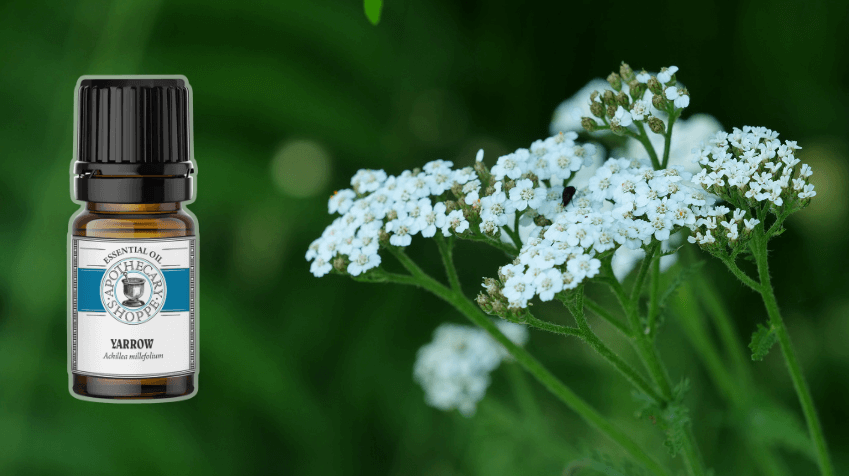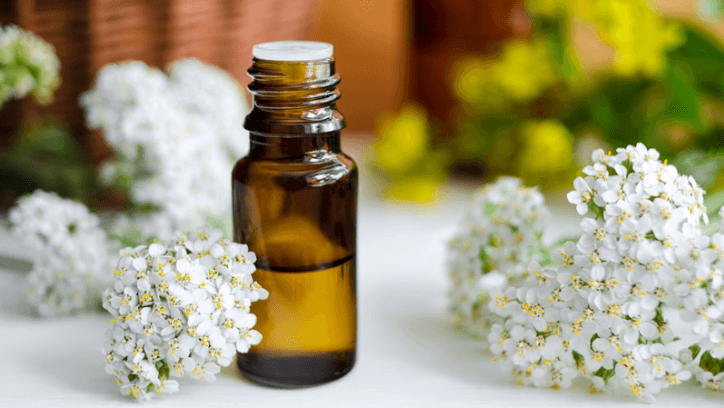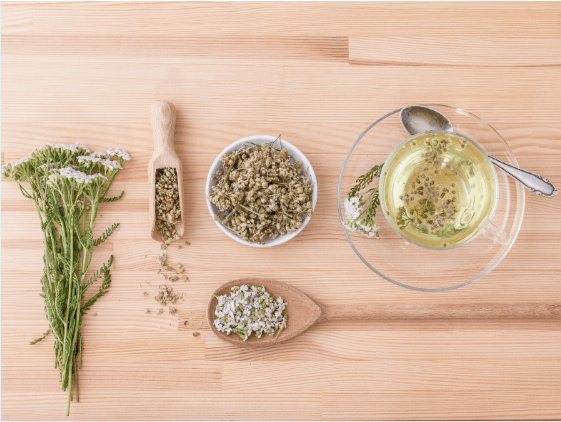Written by ACHS Founding President Dorene Petersen. First published in the International Herb Association "Yarrow Herb of the Year 2024™. Reprinted with permission.
Yarrow Achillea millefolium (L.) essential oil is an often overlooked and underappreciated treasure. There is a notable lack of clinical trials on yarrow’s uses and benefits, but many aromatherapists are well aware of this blue herb’s powerful potential. Its delicate petals and leaves hold a multitude of therapeutic actions, from antimicrobial and antifungal to anti-inflammatory properties. Looking deeper into its history and complex chemistry, we'll uncover the nuances of yarrow essential oil and explore the essential aspects of ensuring its quality and authenticity.
The Legend of Achilles: Origins and Symbolism
In Greek mythology, the legendary warrior Achilles was renowned for his valor and prowess on the battlefield. Yarrow's Latin name reveals its connection to this legend. The genus Achillea was named after Achilles. It's said that he applied healing poultices of yarrow to the wounds of his fellow soldiers during the fabled battle of Troy.1 Additionally, the Latin moniker millefolium, meaning "a thousand leaves," pays homage to the herb’s intricate leaf shape2. From its mythical origins to its taxonomical identity, yarrow's legacy is steeped in symbolism and substance.
Yarrow’s Documented Heritage
Across historical eras and civilizations, yarrow has appeared in medicinal traditions around the globe. From the documented accounts of Pliny the Elder, an ancient Roman naturalist and philosopher, to the writings of John Gerard, an esteemed 17th-century English herbalist, its therapeutic virtues have been extolled through the ages.3,4 Some of yarrow's common names, such as "nosebleed" and "bloodwort," offer glimpses into its historical applications as a potent styptic herb, revered for its ability to staunch bleeding. Its association with warfare earned it the name Herba Militaris, underscoring its ubiquity on battlefields. Beyond its physical properties, yarrow's significance transcended into realms of divination. Its stalks are noted as instruments of ancient oracles in the I Ching, an ancient Chinese divination manual.5
Complex Cultivation and Extraction
Yarrow is native to Europe, Northern Asia, and North America. It's resilient and adaptable, making it fairly easy to grow. It can thrive in diverse environments, from seashores to urban landscapes. However, its essential oil extraction can be challenging due to low yields and intricate distillation processes. Steam distillation is the preferred method to preserve its therapeutic properties. However, the yield from steam distillation is low, so many producers of yarrow essential oil use harmful dilutants and extenders to boost their financial return.
Quality Assurance
 The genus Achillea contains approximately 110 to 140 species.6 Because of this variation in yarrow species, always check the Latin name of your product to avoid buying an essential oil with a constituent profile unsuitable for the outcome you hope to achieve. The purity and authenticity of yarrow can also be revealed using refined evaluations of the herb through sight, smell, and touch. Look for vibrant hues of blue, which indicate high-quality chamazulene levels. Pale green, grey, or black coloring can mean the oil has oxidized, reducing its therapeutic value.
The genus Achillea contains approximately 110 to 140 species.6 Because of this variation in yarrow species, always check the Latin name of your product to avoid buying an essential oil with a constituent profile unsuitable for the outcome you hope to achieve. The purity and authenticity of yarrow can also be revealed using refined evaluations of the herb through sight, smell, and touch. Look for vibrant hues of blue, which indicate high-quality chamazulene levels. Pale green, grey, or black coloring can mean the oil has oxidized, reducing its therapeutic value.
Organoleptic testing, the act of observing an oil with all 5 senses, can be done to determine quality. You can use feel, aroma, and visual inspection to conduct evaluations. Some experts and professionals also taste a tiny drop of essential oil on the tip of the tongue as part of organoleptic testing. However, this is not recommended for anyone without clinical training in the safe use of essential oils.
Yarrow essential oil is an under-appreciated gem in the world of holistic wellness. It has a rich history, mythology, and botanical complexity and is cherished by aromatherapists for its therapeutic properties. From its legendary association with Achilles to its documented heritage in medicinal traditions across cultures, yarrow has a strong legacy of healing and resilience. Once you become familiar with how to identify high-quality yarrow, you can enjoy its many great benefits!
Learn more about the International Herb Association Herb of the Year program.
Disclaimer:
This content is for educational purposes only and is not intended to be medical advice. It is not intended to treat, diagnose, cure, or prevent disease. This article has not been reviewed by the FDA. Always consult with your primary care physician or naturopathic doctor before making any significant changes to your health and wellness routine.
Sources:
1) Applequist, W. L. & Moerman, D.E. (2011). Yarrow (Achillea millefolium L.): A neglected panacea? A review of ethnobotany, bioactivity, and biomedical research. Economic Botany, 65, 209–225. https://doi.org/10.1007/s12231-011-9154-3
2) United States Department of Agriculture. (n.d.). Plant of the week: Common Yarrow (Achillea millefolium). https://www.fs.usda.gov/wildflowers/plant-of-the-week/achillea_millefolium.shtml
3) Applequist, W. L. & Moerman, D.E. (2011). Yarrow (Achillea millefolium L.): A neglected panacea? A review of ethnobotany, bioactivity, and biomedical research. Economic Botany, 65, 209–225. https://doi.org/10.1007/s12231-011-9154-3
4) Gerard, J. (1545-1612). The herball or Generall historie of plantes. Gathered by Iohn Gerarde of London Master in Chirurgerie very much enlarged and amended by Thomas Iohnson citizen and apothecarye of London. Adam Islip Ioice Norton and Richard Whitakers, anno 1633.
5) Zheng, X. & Cao, Y. (2023). Big data analyzing the asymmetry of 64 hexagrams based on the Yarrow-stalk method. 2023081347. https://www.preprints.org/manuscript/202308.1347/v1
6) Applequist, W. L. & Moerman, D. E. (2011). Yarrow (Achillea millefolium L.): A neglected panacea? A review of ethnobotany, bioactivity, and biomedical research. Economic Botany, 65, 209–225. https://doi.org/10.1007/s12231-011-9154-3





